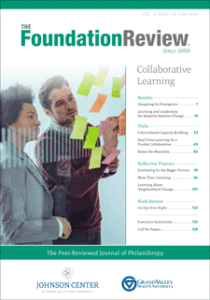Collaborative Learning


 One of the critical components of foundation effectiveness and long-term impact is the ability to learn as organizations, beyond individual staff learning. This type of learning is already difficult, and when you add the complexity of working within systems and networks while trying to change them at the same time, learning is both more difficult and more critical to success. Following up on our issue on Foundation Learning, this latest issue of The Foundation Review focuses on how foundations engage in this more complex learning in collaboration with others, including community members, grantees, and other funders.
One of the critical components of foundation effectiveness and long-term impact is the ability to learn as organizations, beyond individual staff learning. This type of learning is already difficult, and when you add the complexity of working within systems and networks while trying to change them at the same time, learning is both more difficult and more critical to success. Following up on our issue on Foundation Learning, this latest issue of The Foundation Review focuses on how foundations engage in this more complex learning in collaboration with others, including community members, grantees, and other funders.
Two of the articles in this issue report on the results of shared learning efforts, and another three share reflections about learning based on the authors’ experiences. The issue concludes with a review of a new book by Phil Buchanan.
Darling, Guber, Smith, and Lewis write about the McCune Charitable Foundation’s emergent strategy approach that was designed to establish clear goals and then create a platform to ensure that leadership comes from those closest to the work. The authors launched a two-year project to research what emergence might look like in seven complex social-change initiatives, and how the strategy could grow agency and create more sustainable solutions in dynamic environments.
In 2014, the Kansas Health Foundation brought together a group of knowledgeable stakeholders from a multitude of specialties to focus on reducing tobacco use specifically among Kansans with mental illness. Long, Richter, Avers, and Cagan describe how a stakeholder engagement model led to the group’s success in achieving a number of policy, system, and environmental changes — including expanding cessation benefits available under Medicaid in Kansas — and could be replicated by any foundation.
New tools are needed as foundations seek to implement collaborative learning approaches. Funders like the Edna McConnell Clark Foundation are exploring ways to fully engage grantees, co-funders, technical consultants, and evaluators in collective learning and reflection. Taddy-Sandino, Gray, and Scaturro share how the foundation’s cohort-based capacity-building program, PropelNext, was designed to enhance the performance of promising nonprofits that serve America’s disadvantaged youth. They highlight strategies and tools to accelerate change, strengthen funder-grantee interactions, and advance the field.
Chen, Johnson, Alvarez, Harlow, and Price-Letscher describe the Nonprofit Sustainability Initiative, a multiyear collaboration of 17 funders in Los Angeles County, California, that supports nonprofit organizations to collaborate and restructure in a variety of forms. As the initiative evolved, its evaluation and learning system had to have the ability to evolve with it. This article presents key design aspects of the system, describes how it evolved over time, and shares insights and learnings.
In late 2016, four health legacy foundations partnered to launch the Health Legacy Collaborative Learning Circle. Martinie, Love, Kelly, Dueck, and Strunk describe the yearlong process of creating the collaborative, and present a framework that can be used to create learning environments. This learning framework was used to test and expand assumptions about promising approaches to common population health challenges, explore organizational best practices related to programming and operations, and understand the roles and impacts peer health legacy foundations have in their communities.
Kelly, Brown, Yu, and Colombo, four highly experienced foundation evaluation leaders, focus on the need to elevate the role foundations can play in building field-level learning about community initiatives. Many of the documented evaluations of such investments lack translatable lessons specific and influential enough to drive related decisions and actions of others in the field. This article developed from ongoing, multiyear peer learning across several foundations that collectively compiled recommendations for community systems-change funders and evaluators to implement more powerful evaluations.
Nolan, Howard, Gulley and Gonzalez explore how foundations can harness the power of feedback to improve philanthropic practice, using the experiences of the James Irvine Foundation as a case example. They present two cases from the foundation’s own experience gathering feedback from community stakeholders and grantee partners, and then lay out a series of culminating lessons and insights based on this work.
NeighborWorks America and the Wells Fargo Regional Foundation regularly engage in collaborative learning processes with their grantees and partners to support local revitalization practices and inform program and grantmaking strategies. Dahab, Finn, Greco, and Kopf reflect on the key ingredients and processes needed to develop and sustain collaborative learning over time among grantee organizations, community residents, other stakeholders and funding partners, as well as the critical role that providers of technical assistance play.
Putman describes Giving Done Right: Effective Philanthropy and Making Every Dollar Count by Phil Buchanan as a helpful but not oversimplified look at what it takes to be effective philanthropists. Understanding and valuing the role of the sector are necessary first steps — and not surprisingly, learning with grantees and community members is another key ingredient.
There is still much to learn about learning, especially about collaborative learning. For example, we need better understanding of effective practices in managing the learning process, how to use technology to support it, and when and how to communicate to various stakeholders. The articles in this issue share successes, tools, and reflections that demonstrate such learning is both possible and necessary.
We are grateful to the Gordon and Betty Moore Foundation, the Walton Family Foundation, the McKnight Foundation, and the Kauffman Foundation for their sponsorship of this issue, which allows us to make the entire issue open access.